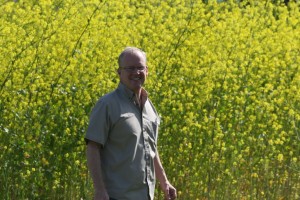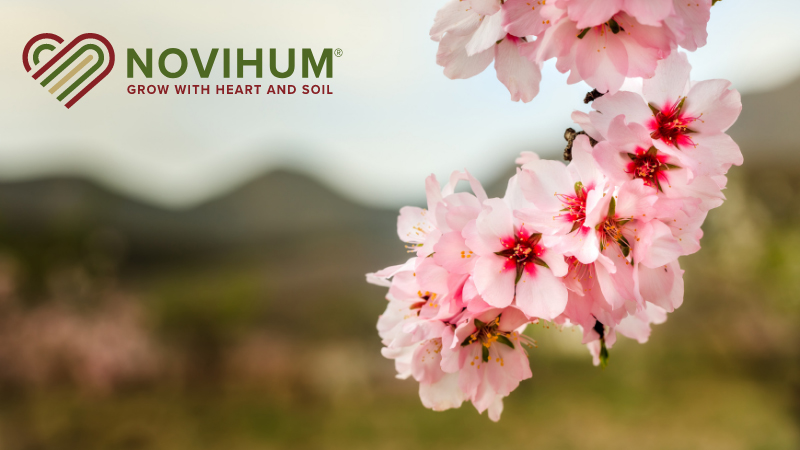The Future Of Almonds And Honeybees

Dan Cummings
Dan Cummings knows a thing or two about honeybees. Not only does he oversee 6,500 acres of almond trees as CEO of Capay Farms, he also was one of the founding directors of Project Apis m., whose mission is to fund honeybee research in an effort to preserve and protect the bee population. We caught up with Cummings to ask him a few questions about the state of the honeybee population and the almond industry’s dependence on a healthy bee population.
Q: How dependent is the almond industry on honeybees?
A: The almond industry is very dependent on honeybees. Almonds are, I believe, the first deciduous fruit tree to bloom at the end of winter – the second week or third week of February. Most varieties of almonds are not self-fertile, and all varieties, I believe, benefit from honeybees for pollination to move the pollen from the stamen of one flower to the stigma of another flower.
It used to be easier to talk about this, because only recently has there become commercially available a self-fertile almond variety. So, 10 years ago, all almonds required cross pollination between different varieties, and the bees are the ones that affected that cross pollination. Recently, there’s an economically viable, commercially available almond variety that is self-fertile. The vendor of that tree also claims that it’s self-pollinating, but I believe, personally, that that variety also benefits from honeybees assisting with the transfer of pollen.
Q: How is the honeybee industry dependent on the almond industry?
A: The value of honey produced in 2014 in the United States was around $385 million. The value of almond pollination services in 2014 was approximately $296 million. So when most people think about honeybees, they think about the source of income for a beekeeper as being the production of honey. But actually, the value of almond pollination was 77% of the value of the commercial honey production in 2014.
Another factoid is that if you look at the cost for me to produce a pound of almonds, all my variable costs – I have water, crop protection products, fertilizer, labor, equipment – around 11% to 14% of my variable cost of producing a pound of almonds is for honeybee rent for three or four weeks in February and March. So these two industries are really dependent on one another.
Q: What role do you feel that you, and the industry as a whole, have in preserving and protecting honeybees?
A: A very important role. Growers, for sure, have a great opportunity to assist in the health and vitality of the honeybees. One way would be forage.
One of the greatest needs that honeybees have now is natural forage. Of course, that’s really evident in California with our fourth year of drought, but as well as across the United States. A lot of Conservation Reserve Program (CRP) ground that had been a source of natural forage for honeybees has been converted to corn production and soybean production. If the honeybee is trying to fight off colony collapse disorder and the varroa mite, one of the single greatest needs is the availability of natural forage. So as a farmer, when I plant my young orchards, I plant perennials that have pollen available for the honeybees along my ditch banks and at the edge of fields where they don’t get in the way. Coyote bush is a great one – it has pollen available in October and November when pollen is generally not widely available for honeybees.
The planting of forage, coordination with my beekeeper on the placement of the hives, on the timing of the placement of the hives, on the timing of my application of crop protection products, about the selection of my crop protection products – that’s the way that growers can play a role for the relatively brief amount of time that honeybees are in the almond orchards.
Q: What are your thoughts on what’s contributing to colony collapse disorder?
A: From the research of which I’m aware, we have been unable to identify a single causal agent, and it looks like the bees are succumbing to cumulative stress. The biggest contributor to that cumulative stress, I believe, is varroa mite, which is a parasite huge in size relative to its host. It would be the equivalent of a person having an orange on their back sucking the hemolymph (blood) from the honeybee, and also acting as a vector for the transmission of viruses. So the varroa mite not only weakens the honeybee by feeding on it but also by transmitting viruses.
So if you look at the cumulative stress of viruses and the varroa mite, pesticides, moving the bees, drought, lack of forage – that’s another huge one – altogether, on occasion it overwhelms the honeybee. And I think the greatest single answer to that is providing more natural forage. Just like a human – if we have a healthy, balanced diet, we’re able to fight off anything that might attack us, and I think that the honeybee is being weakened from lack of abundant forage and is thus less able to fend off different things that are attacking it.
The simple presence of varroa mite [is problematic], though. That’s where Project Apis m.’s greatest focus is – trying to address varroa mite. We, as an industry, believe that if we could somehow eliminate or have much better control products for varroa mite, that the honeybee population would be significantly healthier.
Q: What are your thoughts on the future of the honeybee population?
A: I’m very positive. I think that beekeepers are hard-working and are evolving in their cultural practices and the way they take care of the honeybees. We’re learning a lot with all this research – it was ongoing research with the Agricultural Research Service labs and with the universities, but CCD brought a lot of attention to the honeybee industry and additional funding, so the amount of research has really been ramped up. I think that we’re going to see results from that.









